
Wertheim is a town in southwestern Germany, in the state of Baden-Württemberg with a population of around 23,400. It is located on the confluence of the rivers Tauber and Main. Wertheim is best known for its landmark castle and medieval town centre.

Alte Oper is a concert hall in Frankfurt am Main, Hesse, Germany. It is located in the inner city, Innenstadt, within the banking district Bankenviertel. Today's Alte Oper was built in 1880 as the city's opera house, which was destroyed by bombs in 1944. It was rebuilt in the 1970s as a concert hall with a large hall and smaller venues, opened in 1981. The square in front of the building is still known as Opernplatz.

The Altstadt is a quarter (Stadtteil) of Frankfurt am Main, Germany. It is part of the Ortsbezirk Innenstadt I.
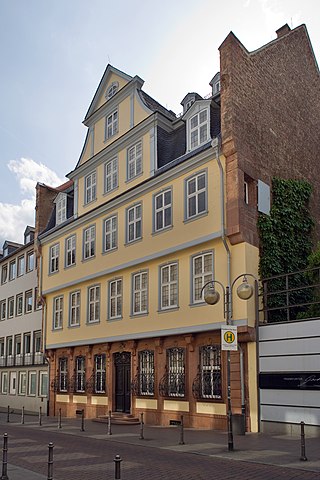
The Goethe House is a writer's house museum located in the Innenstadt district of Frankfurt, Germany. It is the birthplace and childhood home of German poet and playwright Johann Wolfgang von Goethe. It is also the place where Goethe wrote his famous works Götz von Berlichingen,The Sorrows of Young Werther, and the first drafts of Urfaust. The house has mostly been operated as a museum since its 1863 purchase by the Freies Deutsches Hochstift, displaying period furniture and paintings from Goethe's time in the house.

The New Town Hall is a town hall at the northern part of Marienplatz in Munich, Bavaria, Germany. It hosts the city government including the city council, offices of the mayors and a small portion of the administration. In 1874 the municipality had left the Old Town Hall for its new domicile.

Schloss Johannisburg is a schloss in the town of Aschaffenburg, in Franconia in the state of Bavaria, Germany. It was erected between 1605 and 1614 by the architect Georg Ridinger for Johann Schweikhard von Kronberg, Prince Bishop of Mainz. Until 1803, it was the second residence of the Prince Bishop of Mainz. It is constructed of red sandstone, the typical building material of the Spessart, the hills near Aschaffenburg.
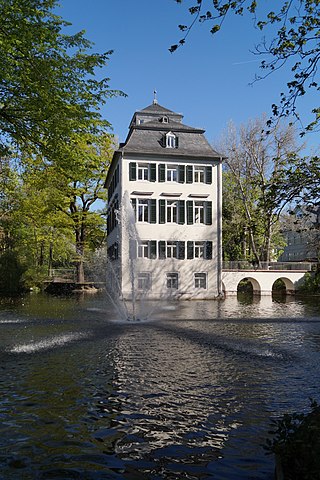
The Holzhausenschlösschen is a moated former country house built by the patrician Holzhausen family on their farm, then just north of Frankfurt and now in the city's Nordend. The present building was completed in 1729, built for Johann Hieronymus von Holzhausen on the foundations of a moated castle from the Middle Ages after a design by Louis Remy de la Fosse. Today, it serves as a venue for cultural events.

The Main Cycleway is a major German bicycle path running for about 600 km along the River Main in Germany. It starts from either Creußen or Bischofsgrün and ends in Mainz. The General German Bicycle Club (ADFC) rated the trail five stars in 2008, the first path in Germany to receive this award. Approximately 90% of the path is paved and 77% of the route is at least 2.5 metres wide.
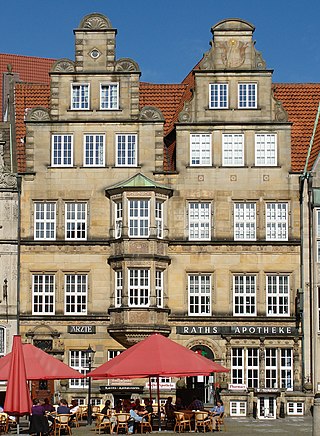
The Raths-Apotheke is a listed building on the Market Square (Marktplatz) in Bremen, Germany. After suffering war damage, the building was restored with two gables in the Neobaroque style in 1958, re-establishing the square's sequence of gabled buildings dating from the 1820s.
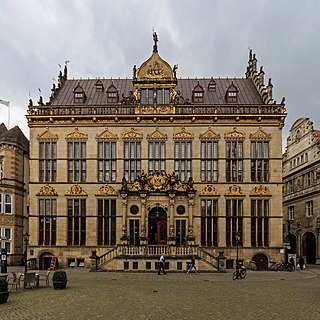
The Schütting, situated on the Marktplatz in Bremen, initially served the city's merchants and tradesmen as a guild house. In 1849, it became Bremen's chamber of commerce. Since 1973, it has been under monument protection. It lies on the south site of the Bremen marketplaces directly across from the town hall.
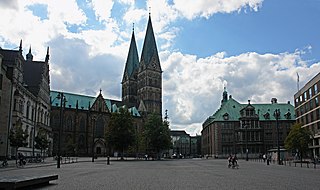
The Domshof is a town square in Bremen, north of the cathedral and the Marktplatz. The Domshof is used for markets as well as larger outdoor events, particularly May Day demonstrations.

The New Frankfurt Old Town is the centre of the old town of Frankfurt am Main, which was reconstructed from 2012 to 2018 as part of a major urban development project called the Dom-Römer Project. The project redesigned and developed a 7,000 square meter property between Römerberg in the west and Domplatz in the east, delimited by Braubachstrasse in the north and the Schirn Kunsthalle in the south, in an effort to remake the old city centre, the Altstadt of Frankfurt am Main, Germany, which was severely damaged during World War II, in the style of the pre-war architecture.

Paulsplatz is a historic square in the heart of Frankfurt, Germany. St Paul's Church is located here, dominating the square. The Römerberg, another square, is to the south. Berliner Strasse is immediately to the north. Paulsplatz is a major location for the outdoor Frankfurt Christmas Market.

The castle in Forchheim, also referred to as a royal palace or Kaiserpfalz, was an important urban castle under the bishops of Bamberg in the town of Forchheim in the south German state of Bavaria. The castle was built in the late 14th century. After comprehensive archaeological and architectural-historical investigation it has become one of the best researched castles of this period in Central Europe. Today it houses the Archaeological Museum of Upper Franconia.
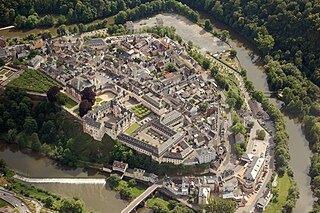
Schloss Weilburg is a Baroque schloss in Weilburg, Hesse, Germany. It is located on a spur above the river Lahn and occupies about half of the area of the Old Town of Weilburg. It contains the Hochschloss, built between 1530 and 1572, which is one of the best-preserved Renaissance palaces in Hesse. In the 1700s, the palace was expanded by John Ernst, Count of Nassau-Weilburg, and his builder, Julius Ludwig Rothweil. The buildings and gardens now belong to the Verwaltung der Staatlichen Schlösser und Gärten Hessen, and they can be visited as a museum on guided tours. Parts of the palace are venues for the music festival Weilburger Schlosskonzerte, which is named after the palace.

The Haus zur Goldenen Waage is a medieval half-timbered house in the old town of Frankfurt am Main, which was destroyed in the air raid on 22 March 1944. Because of its high architectural and historic value, it is one of the most famous sights of the city. It is situated in front of the main entrance of the cathedral on the corner of the narrow Höllgasse, which leads from the cathedral square to the Römerberg and Altstadtgasse.
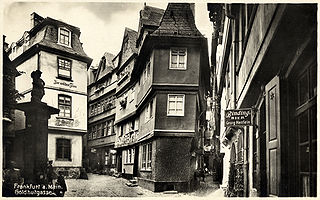
The Five-Finger Square was a small place in the old town of the German city of Frankfurt am Main, which was formed by the meeting of five narrow streets. It was east of the east line of the Römerberg market square, south of the market street, west of the Langen Schirn and north of Bendergasse. The popular postcard motif and tourist destination was destroyed in an air raid on March 22, 1944. Instead of a possible reconstruction, the city decided after the war to remove the rubble. The area was built over in the early 1970s and with the construction of the Römerberg-Ostzeile from 1981 to 1983 and the Kunsthalle Schirn from 1984 to 1986. The western entrance to the Schirn Rotunda is located on the site of the former Five-Finger Square, making reconstruction impossible.

The Bendergasse was a former major street in the old town of Frankfurt. It ran from near Frankfurt Cathedral to the Römerberg square. From the Middle Ages till the destruction in the air raid on 22 March 1944, it formed one of the main streets in the old town centre. It was a densely built street with gabled, multi-level and multi-cantilevered half-timbered houses in Gothic and Baroque architectural styles. It was one of the most picturesque streets in the old town and served as a motif for numerous artists from the 19th century till its destruction.

The Salzhaus is a historic building in the German city Frankfurt am Main. It forms the northeastern part of the Frankfurt City Hall complex (Römer), on the Römerberg square in the centre of the Altstadt.
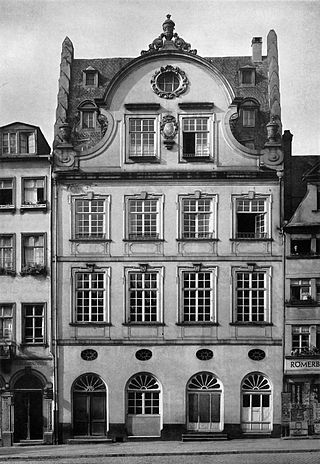
Lichtenstein House, frequently called just Lichtenstein or Little Roman, was a historical building in the Altstadt of Frankfurt am Main and has an interesting architectural history, which combines the Gothic and the Baroque style. It was located in a residential block of the Römerberg, south of a building called Römer. The address was Römerberg 11.























